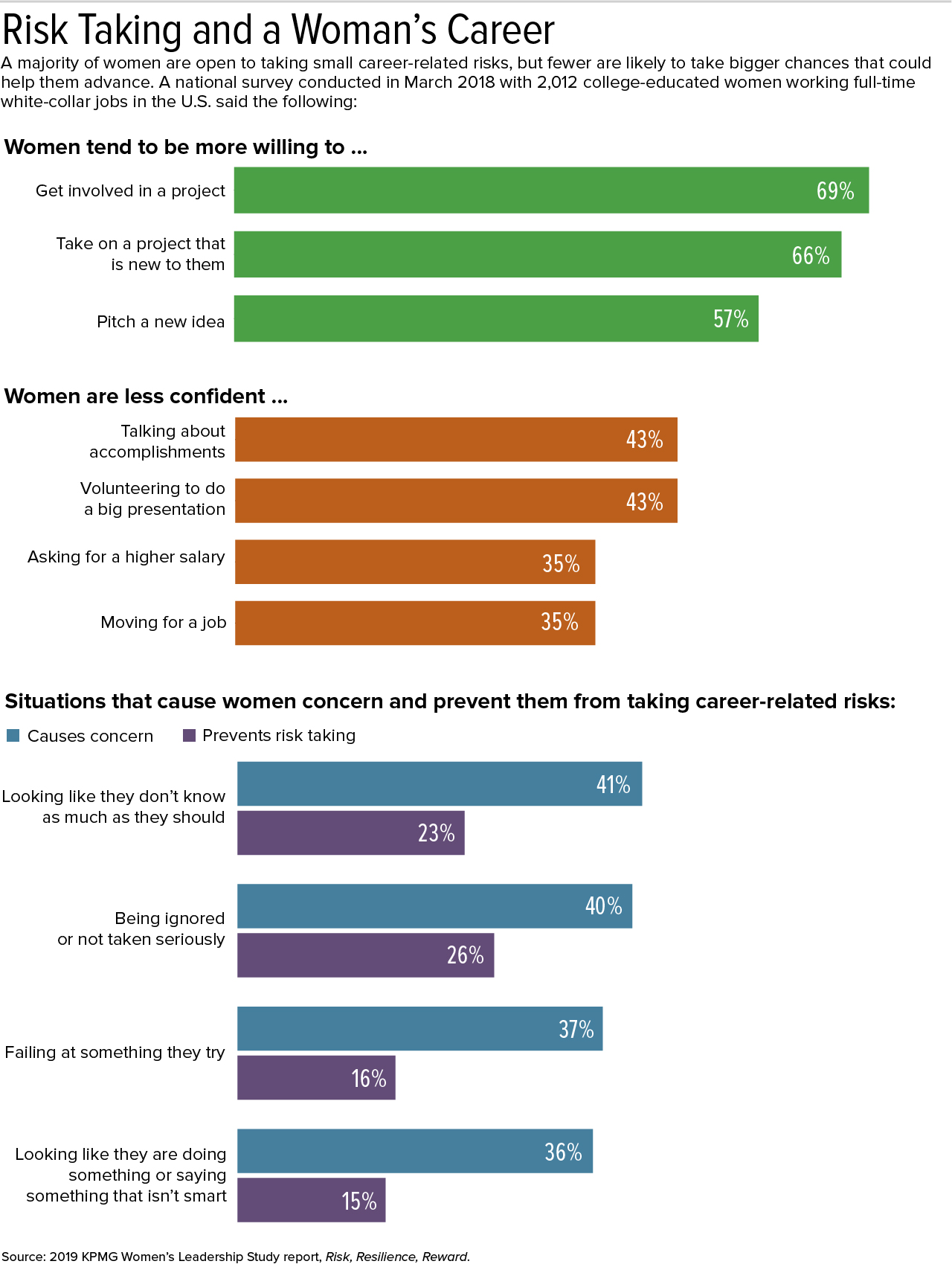Taking risks can benefit a career and boost workers into leadership positions.
But while women are willing to take on what they consider small risks—a new project or pitching an idea—they are less inclined to engage in bigger risk taking such as asking for a higher salary or moving for a job, according to a new women's leadership study from KPMG.
It's not that women don't see the benefits. More than half (55 percent) of the women who responded to KPMG's survey said people who take more career risks progress more quickly than others and benefit in other ways, too—by gaining confidence, developing new skills and earning colleagues' respect, for example.
Even so, women often limit their risk taking and tend to be more comfortable taking professional chances that benefit their group or company than ones that benefit themselves, regardless of the size of the risk or their years of experience. While 66 percent are willing to take on a new project, only 35 percent are confident about asking for a higher salary.
Women's willingness to take risks ebbs as they gain experience and confidence, the study found. Nearly half (45 percent) of women with less than five years of experience are open to taking big career risks, while just over one-third (37 percent) of women with 15 or more years of experience are willing to do so.
The findings are based on a national survey conducted in March with 2,012 college-educated women working full time in white-collar jobs in the U.S.
"When it comes to their careers, many women find themselves in a bit of a bind. They're trying to preserve their gains, so instead of playing to win, they're often playing not to lose—whether hesitating to take perceived big risks or feeling the need to take outsized chances," said Michele Meyer-Shipp, Esq., KPMG's chief diversity officer. She is based in Newark, N.J.
When they achieve success, women tend to credit it to good work habits such as being detail-oriented and organized and are less likely to cite attributes such as risk taking and leadership skills.
The findings, Meyer-Shipp said, "made me think about, and question, some of the decisions I made around my career." The study showed her that "the concerns and fears I had about risk taking were not unique to just me."
[SHRM members-only toolkit: Developing Organizational Leaders]
Doug Sundheim, author of Taking Smart Risks When the Stakes Are High (McGraw-Hill, 2013), thinks women are risk takers but often aren't seen that way because the definition of risk taking often is framed narrowly in physical and financial terms.
"[Those terms] don't point to risks like standing up for what's right in the face of opposition," he wrote in Harvard Business Review, "or taking the ethical path when there's pressure to stray—important risks that I've found women are particularly strong at taking."
The so-called small risks that KPMG asked women if they were confident taking included voicing a point of view or opinion, even if it conflicts with others; taking action to raise their visibility, such as attending a networking event; and reaching out to someone they didn't know well to mentor or sponsor them.
Among the big risks the company asked about: requesting a more flexible or accommodating working situation, questioning the status quo, and re-entering the workforce if planning to leave it for a while.

Developing the Risk-Taking Muscle
Although asking for a salary bump is among actions women are less confident about taking, the study found that money is the top motivator for taking a career risk. A supervisor who encourages employees to try new things also prompts risk taking.
"That comes with having a supportive organizational culture," Meyer-Shipp said.
Seven in 10 respondents (71 percent) said their company supports risk taking and the failures that may result.
For organizations looking to create this type of culture, Meyer-Shipp suggested the following strategies.
Develop career advisors. "You may not go to them for every issue you're navigating, but [they can] help you really think about your path forward and your [career] trajectory," Meyer-Shipp said.
It helps many young employees, she noted, to have someone tell them what roles they need to step into and the types of relationships they need to build to advance their careers.
"It depends on where you work, but the most logical choice would be someone in your talent development department of your organization who really understands the lines of succession … [and] literally plan out from Step A to Step B 'here are the things you need to do.'
"Some organizations have hired full-time dedicated resources for this; others have identified people who want to do this as a stretch assignment. In some instances, [the organization uses its] employee assistance program."
Encourage risk taking. Respondents said they would like to see more of this from their organizations. Some companies require leaders to have a talent management goal, such as offering stretch assignments, in addition to a business goal.
Offer more training opportunities.
Give employees flexibility to try new things. Meyer-Shipp recalled a friend who worked at a major global organization and wanted to form a group that supported women in the legal profession. She was hesitant to approach her boss with the idea, but when she did she not only got approval but also organizational resources—office space for meetings, her own team's assistance—to help her make her vision a reality. The risk paid off: Today the group is a premier multicultural professional development organization, according to Meyer-Shipp.
"Women may benefit by taking more risks over the course of their careers, but they can't go it alone," she stated. "Organizations must provide supportive structures, including inclusive and diverse workplaces, professional development, mentorship, and sponsoring opportunities—all of which set up women to achieve, thrive and reach the highest levels."
Advertisement
An organization run by AI is not a futuristic concept. Such technology is already a part of many workplaces and will continue to shape the labor market and HR. Here's how employers and employees can successfully manage generative AI and other AI-powered systems.
Advertisement



